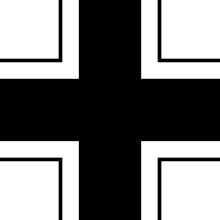 Global Information
Global InformationWehrmacht information
| Wehrmacht | |
|---|---|
 Reichskriegsflagge, the war flag and naval ensign of the Wehrmacht (1938–1945 version) | |
 Emblem of the Wehrmacht, the Balkenkreuz, a stylized version of the Iron Cross seen in varying proportions | |
| Motto | Gott mit uns[3] |
| Founded | 16 March 1935 |
| Disbanded | 20 September 1945[a] |
| Service branches |
|
| Headquarters | Maybach II, Wünsdorf 52°10′57″N 13°28′27″E / 52.1826°N 13.4741°E |
| Leadership | |
| Supreme Commander (1935–1945) |
|
| Commander-in-chief (1935–1938) |
|
| Minister of War (1935–1938) | Werner von Blomberg |
| Commander-in-chief of the Wehrmacht High Command | Wilhelm Keitel |
| Personnel | |
| Military age | 18–45 |
| Conscription | 1–2 years; compulsory service |
| Reaching military age annually | 700,000 (1935)[4] |
| Active personnel | 18,000,000 (total served)[5] |
| Expenditures | |
| Budget |
|
| Percent of GDP |
|
| Industry | |
| Domestic suppliers | See list
|
| Foreign suppliers |
|
| Annual exports | 245 million ℛℳ (1939) (€1090 million in 2021)[10] |
| Related articles | |
| History | History of Germany during World War II |
| Ranks |
|
The Wehrmacht (German pronunciation: [ˈveːɐ̯maxt] ⓘ, lit. 'defence force') were the unified armed forces of Nazi Germany from 1935 to 1945. It consisted of the Heer (army), the Kriegsmarine (navy) and the Luftwaffe (air force). The designation "Wehrmacht" replaced the previously used term Reichswehr and was the manifestation of the Nazi regime's efforts to rearm Germany to a greater extent than the Treaty of Versailles permitted.[11]
After the Nazi rise to power in 1933, one of Adolf Hitler's most overt and bellicose moves was to establish the Wehrmacht, a modern offensively-capable armed force, fulfilling the Nazi regime's long-term goals of regaining lost territory as well as gaining new territory and dominating its neighbours. This required the reinstatement of conscription and massive investment and defence spending on the arms industry.[12]
The Wehrmacht formed the heart of Germany's politico-military power. In the early part of the Second World War, the Wehrmacht employed combined arms tactics (close-cover air-support, tanks and infantry) to devastating effect in what became known as Blitzkrieg (lightning war). Its campaigns in France (1940), the Soviet Union (1941) and North Africa (1941/42) are regarded by historians as acts of boldness.[13] At the same time, the extent of advances strained the Wehrmacht's capacity to the breaking point, culminating in its first major defeat in the Battle of Moscow (1941); by late 1942, Germany was losing the initiative in all theatres. The German operational art proved no match to that of the Allied coalition, making the Wehrmacht's weaknesses in strategy, doctrine, and logistics apparent.[14]
Closely cooperating with the SS and their Einsatzgruppen death squads, the German armed forces committed numerous war crimes (despite later denials and promotion of the myth of the clean Wehrmacht).[15] The majority of the war crimes took place in the Soviet Union, Poland, Yugoslavia, Greece, and Italy, as part of the war of annihilation against the Soviet Union, the Holocaust and Nazi security warfare.
During World War II about 18 million men served in the Wehrmacht.[16] By the time the war ended in Europe in May 1945, German forces (consisting of the Heer, the Kriegsmarine, the Luftwaffe, the Waffen-SS, the Volkssturm, and foreign collaborator units) had lost approximately 11,300,000 men, about 5,318,000 of whom were missing, killed or died in captivity.[17] Only a few of the Wehrmacht's upper leadership went on trial for war crimes, despite evidence suggesting that more were involved in illegal actions.[18][19] According to Ian Kershaw, most of the three million Wehrmacht soldiers who invaded the USSR participated in war crimes.[20]
- ^ Allied Control Authority 1946a, p. 81.
- ^ Allied Control Authority 1946b, p. 63.
- ^ Armbrüster 2005, p. 64.
- ^ Müller 2016, p. 12.
- ^ Overmans 2004, p. 215.
- ^ Harrison 2000, p. 10.
- ^ Tooze 2006, p. 181.
- ^ Evans 2008, p. 333.
- ^ Department of State 2016.
- ^ Leitz 1998, p. 153.
- ^ Taylor 1995, pp. 90–119.
- ^ Kitchen 1994, pp. 39–65.
- ^ Van Creveld 1982, p. 3.
- ^ Müller 2016, pp. 58–59.
- ^ Hartmann 2013, pp. 85–108.
- ^ Overmans 2004, p. 215; Müller 2016, p. 16; Wette 2006, p. 77.
- ^ Fritz 2011, p. 470.
- ^ Wette 2006, pp. 195–250.
- ^ USHMM n.d.
- ^ Kershaw 1997, p. 150.
Cite error: There are <ref group=lower-alpha> tags or {{efn}} templates on this page, but the references will not show without a {{reflist|group=lower-alpha}} template or {{notelist}} template (see the help page).